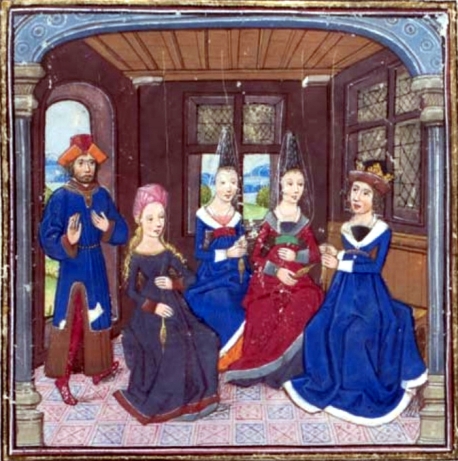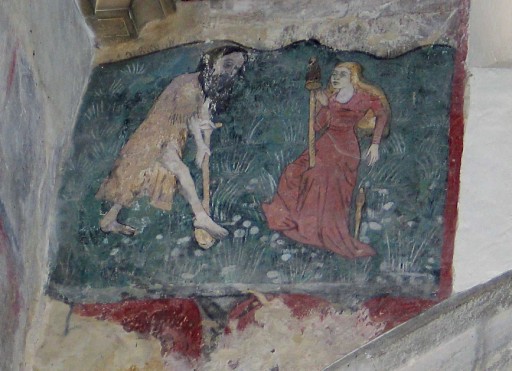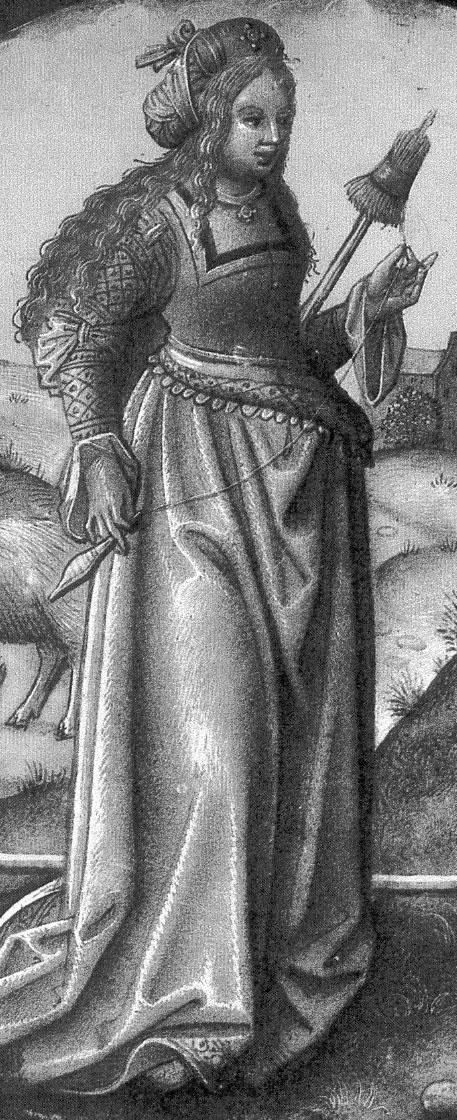For An Tir's Twelfth Night 2015, I decided to start a whole new project and do some practical research while I was at it. The Dirty Dozen Largesse Derby provided me with the motivation to make a collection of handmade spindles and discover how they might have been constructed and used. Unfortunately, real life got in the way and I was not able to enter my spindles in the derby, but the project started an investigation into how spinning was done by everyday people before spinning wheels became widespread, and before the Industrial Revolution drastically changed the way textiles were made.
There were a few things I wanted to keep in mind for this project:
-First, it is important to remember that people in the middle ages would have mastered spinning at a very early age. First, since it was a vital skill, spinning was ubiquitous and a normal part of daily life. As such the spinners probably could spin much more nimbly than most people in this century. It was important to remember that certain skills that are difficult for modern people may have been second nature for these lifelong spinners. This is important because it means we cannot discard a technique like using a distaff as improbable just because it feels clumsy to us.
-Second, because spinning was so important, the spindle was first and foremost a tool and not an ornament. There are instances of decorated spindles, particularly in graves, but the vast majority of the spindles made were almost purely utilitarian in nature. They had to be as practical and efficient as possible with the technology and techniques known at the time.
-Third, it is important to discard preconceived notions of what spindle spinning may look like. Most people who spin on spindles today use drop spindles, whether they are top or bottom whorl. Some use supported spindles and other variants, but I'd hazard a guess that at least 90% of spindle spinning done in the 21st century is done on a modern-style drop spindle without a distaff. In order to approach this project with as little bias as possible, I started by completely discarding the idea of a drop spindle. If the evidence pointed me toward the drop spindle as the tool of choice, it would be because the evidence supported it and not because that is the spindle I know best.
So, what was I left with? The most essential basis of what I needed to create was that I needed a tool that could twist wool, linen, etc. into yarn that was good enough and consistently thin enough to be woven into usable fabric. I needed to follow the techniques and tools that we know were available at the time and, when possible, I needed to use the evidence we already have for what spindles looked like and how they were used.
Due to the volume of archaeological evidence, most of the extant pieces (spindle whorls, spindles) I reference here are from the Viking-Age towns of Birka, Kaupang, and Hedeby. For evidence of how spindles were used, I rely primarily on visual evidence from later Medieval illuminations, tapestries, and other artistic depictions. As a secondary source of information, I also reference the design of the spindle whorls as these can indicate the intended method of spinning.
The Materials
The extant spindle whorls from the middle ages show us that they could be made out of a wide variety of materials. In Scandinavia alone we have a body of evidence containing 1356 whorls and 46 spindles dating between the 8th and 15th centuries alone. The whorls are made from amber, antler, bone, clay, coral, glass, metal, lead, wood, and stone
(1)(2) and generally weigh between 10 and 30 grams. Diameters cover a wide range that generally can be matched to the density of the material. Soapstone, a heavy stone that is relatively easy to carve, generally was carved into whorls between 3 and 5 centimeters in diameter, though there was one as small as 2cm
(1). One could argue that some of the spindle whorls found might have been mislabeled as whorls when in fact they may have been used as beads. This is particularly possible for some of the more precious materials like amber, glass, and coral.
For my spindle whorls, I selected stone and wood in diameters that range between 3 and 5 centimeters depending on shape. Some of the whorls I was able to obtain have more of a donut shape rather than a spherical shape, which means they can have a larger diameter while weighing approximately the same as the spherical versions. It should also be noted that many of the stone whorls are made of semiprecious materials. While plausible, the use of precious stones as spindle whorls is not representative of common Medieval practice and is primarily a result of the materials that were available when I was buying my whorls.
Extant spindles, of which there are fewer, were generally between 7 and 12mm in diameter and 20 to 30cm long
(1). I chose diameters that would fit my whorls snugly, which wound up being between 6 and 16mm. My first spindles were cut into 9 inch lengths from a 36 inch dowel, so they were all about 22cm. For the next few, I may cut the dowels into 12 inch lengths for a length of 30cm. My measurements may not necessarily be spot-on, but these spindles will definitely be in the right range.
The Design
The spindles I made were fashioned after medieval drawings and extant spindle whorls. Looking at images of the whorls on display at the museum in Birka
(3), the whorls used ranged in shape from semi-spherical to discoid or donut-shaped. My first source mentioned quite a lot of whorls that were flat on one side and convex on the other (planoconvex). I don't see those in the images from Birka, but 37% of the spindle whorls found at Kaupang had this planoconvex shape. Another 29% of the Kaupang whorls were of a conical shape, which evidence suggests would have produced a faster spin, but they do not have much torque so they would be more suitable for wool than for plant fibers
(2). Another quarter of the whorls had a regular disc or donut shape. Very few (4 out of 121) of the Kaupang whorls were spherical, which makes sense for a drop-spindling context. Combined with the thick spindle shafts, a spherical whorl would neither spin quickly nor have much torque, though they are quite useful for a style of supported spindling where the spindle is continuously spun between the fingers instead of being spun and left to hang. This type of supported spindling is used in modern Russian support spindles and it is my belief that a variant of Russian supported spindling was one style of spinning used immediately after the spindle was invented, but before drop spindling became the norm.
It looks as though the material of the whorl played a part in determining the shape of the whorl, or vice versa
(2). Conical whorls were primarily made from lead or clay, while the discoid an spherical/semispherical whorls were more commonly stone. My guess is that the pliable nature of clay and (possibly) the castable/pliable nature of lead made It easier to form a cone, while stone whorls could be carved or sanded either by hand or lathe into a round shape.
 |
| Stone spindle whorls from the museum on the island of Birka, Sweden. |
As one can see from the image, the holes in the Birka whorls are rather large in proportion to the size of the whorls themselves. As such, the whorls I used had holes that were as large as possible to accommodate what I imagine were fairly thick spindle shafts. My sources did not seem to indicate that the whorl holes were measured in addition to the extant spindle shafts, but I expect that the holes would closely match the sizes of spindles that were measured.
The design of the spindle shafts posed a greater problem than the design of the whorls. My initial design was based almost entirely off the Russian support spindles because there are so few extant spindle shafts and most artistic depictions of spinning show a mostly full spindle, which makes it difficult to see the underlying shape. However, further investigation yielded a slightly different design. There are a few extant spindle shafts discussed in the book
Woven Into the Earth: Textiles from Norse Greenland that are presented in beautifully detailed pictures along with detailed measurements. In contrast to the vaguely conical spindle shape of a modern Russian spindle, these Greenlandic Norse spindles were the same diameter along most of the shaft with a slight bulge near one end that was roughly twice the diameter of the rest of the spindle at its largest point. Also notable is that not all of these spindles showed signs of wear by a whorl, which implies that a whorl was not always necessary for spinning. It should be mentioned, however, that Greenlandic Norse methods of spinning were not always standard, as evidenced by the relative absence of distaffs in the archaeological record and testimony by contemporaries that described Norse Greenlanders as using their heads as distaffs. Despite this regional difference, I would hazard a guess and say that the spindle designs of Norse Greenland did not differ greatly from spindle design in less remote areas.
Lessons Learned
- Spindle whorls from the Middle Ages took a wide range of forms, but most of them were made of stone or wood, weighed between 10 and 30 grams, and were discoid, hemispherical, or spherical in shape.
- Spindle shafts from the Middle Ages were usually between 20 and 30 cm long, mostly a consistent diameter, and usually had a bulge of some sort on one end.
- Hooks on spindles were not unknown, though they were likely not as common as hookless spindles.
Pictures of the Finished Spindles (Upcoming)
Sources
Carolyn Priest-Dorman. Medieval North European Spindles and Whorls. Vassar. 2000. <http://www.cs.vassar.edu/~capriest/spindles.html>.
Ingvild Oye.
Textile-Production Equipment. Things from the Town. Artefacts and Inhabitants in Viking-age Kaupang. Ed: D. Skre. Kaupang Excavation Project Publication Series, vol, 3, Aarhus University Press, pp 339-372. <https://www.academia.edu/1168001/Textile-production_Equipment>.
Birka Artifacts. <http://users.stlcc.edu/mfuller/BirkaArtifacts.html>.



